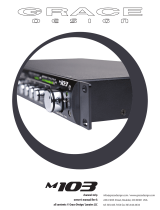
off, the LED will illuminate if voltage is being fed from an external source. (i.e.
when using a direct split in a remote recording application.)
4. PHASE REVERSE The phase reverse switch (labeled ∅∅) reverses the absolute
polarity of the music signal at the input of the preamplifier. The switch illuminates
green and provides power for a sealed gold contact relay located on the
preamplifier circuit board. This eliminates signal wiring to the front panel and
switch contact performance problems.
5. 20dB ATTENUATOR The 20dB attenuator switch (labeled -20) attenuates the
input signal 20dB. The switch illuminates amber when engaged. Like the phase
reverse switch, this switch controls a sealed Gold contact relay on the
preamplifier circuit board. With the -20 switch engaged, the effective gain range
becomes -2dB to 44dB.
6. PEAK INDICATOR The LED peak indicator, which monitors the output signal,
turns green at -14dB and switches to red at +16dB (12dB before clipping in
balanced mode and 6dB before clipping in unbalanced mode). The threshold
level for peak indication is adjustable on each channel. See section V.
Maintenance.
7. MEMO PAD The Memo pad can be used with dry-erase or wet-erase type
markers. If using dry-erase markers, black is recommended. Grease pencils are
not recommended.
B. SETTING THE GAIN
1. Turn the gain control fully counter-clockwise, turn the trim control fully clockwise
and check that the +48V phantom power is off. Connect the microphone and
then turn on the phantom power if required. When sending a signal to a tape
recorder that has fixed input levels, simply increase the gain until the optimum
recording level is reached. If the peak indicator flashes red excessively with the
gain control in the fully counterclockwise position, engage the -20dB attenuator.
2. When sending a signal to a tape recorder with an input attenuator use the
following procedure: With the sound source present, turn the preamplifier gain
control clockwise until the peak LED begins flashing red, then reduce the gain
until the red stops flashing. Since red indicates a peak level which is 12dB
before clipping (6dB in unbalanced mode) it is OK for it to come on periodically
during recording. If peak indicator flashes red excessively with the gain control in
the fully counterclockwise position, engage the -20dB attenuator. Adjust the
recorder input control for the optimum recording level.
3. The trim control can be used for ultra fine output level adjustment as well as for
level riding during recording. It should be noted that the maximum output level of
the preamplifier is reduced by the amount of output attenuation being used. For
instance, if the trim is set to -6dB the maximum output level of the preamplifier
will drop from +28dBu to +22dBu. Since the LED peak indicator monitors signal
Page 3















